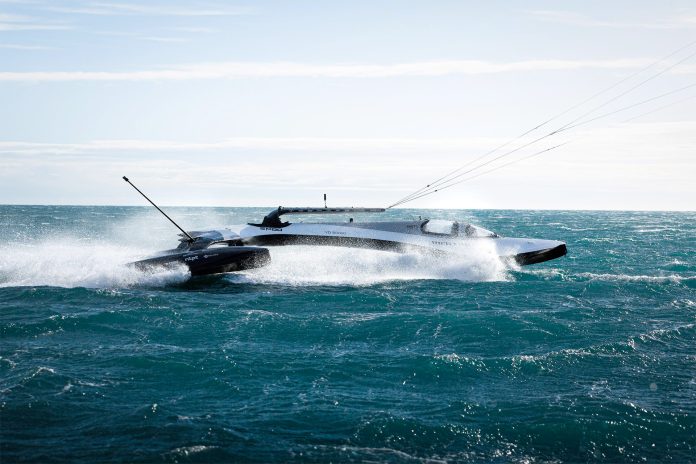A kite-powered sailboat developed by Swiss engineering team SP80 is now officially the second-fastest sailing craft in history, edging closer to breaking the long-standing world speed sailing record set over a decade ago.
The SP80 boat recently reached a peak speed of 58.261 knots (67.1 mph or 108 km/h) during test runs off the southern coast of France. This puts it just a few knots shy of the current world record of 65.37 knots (75.23 mph or 121.06 km/h), which was set by Paul Larsen in 2012 with the Vestas Sailrocket 2.
But the team behind SP80 isn’t just aiming to beat that mark—they’re targeting speeds well beyond it. According to the developers, their ultimate goal is to exceed 80 knots, or around 150 km/h, a benchmark no sailboat has ever reached.
A different approach to speed
What makes SP80’s design notable is its complete departure from the hydrofoil-based approach used by many modern high-speed sailing vessels. Instead of trying to fly above the water to reduce drag, the SP80 remains in contact with the surface using a wide, lightweight trimaran hull measuring 10 meters (33 feet) long and 7 meters (23 feet) wide.
The reason for avoiding hydrofoils? According to the team, cavitation—a phenomenon where water boils into vapor under low pressure created by high-speed underwater wings—becomes a major problem at speeds over 60 mph (~100 km/h). Cavitation can lead to drag spikes and serious instability, both of which would jeopardize record-breaking attempts.

Instead of a mast and sails, SP80 is powered by a large kite, which acts like a giant parachute. This kite is tethered to the boat via cables and is mounted to a wing-like control arm that extends from the left side of the craft. This configuration enables the kite to generate enormous pulling force, which the boat converts into forward motion—while also resisting the sideways and lifting forces that come with kite propulsion.
To maintain stability, a foil blade on the right side of the boat exerts a downward pull, counteracting the kite’s upward lift. The asymmetric setup is key to balancing the massive forces involved at high speeds.
Dual-pilot operation
Operating the SP80 at such high speeds is far from a solo affair. The boat is designed with two tandem cockpits: one in front for the pilot handling the steering, and one behind for a second crew member solely focused on managing the kite.

The team has emphasized the importance of maintaining both control and safety at extreme speeds. As SP80 pilot Mayeul van den Broek explained in a recent press release:
“This is a major milestone for the entire team. Very few sailboats in history have broken the 100-km/h barrier, and weʼre now tangibly closing in on our ultimate goal. Whatʼs especially encouraging is being able to repeat those speeds multiple times throughout the week. It confirms not only the boatʼs reliability, but also its capacity to go even faster. From here, the work continues: analyzing the data on land, and refining our handling on the water as soon as the wind allows.”
Still short of the official mark
Despite the impressive peak speed, there’s a technicality. To qualify for the official World Sailing Speed Record Council certification, a sailing craft must sustain its average speed over a 500-meter (1,640-foot) run. In this context, SP80’s best measured pass so far stands at 48.645 knots (56 mph or 90 km/h)—well below Larsen’s benchmark.
Still, the SP80 team remains optimistic. Continued testing is planned off the coasts of Leucate and Port-La Nouvelle in southern France, where wind conditions are ideal for pushing the boat to its limits.

What happened to Syroco?
Interestingly, the SP80 wasn’t the only kite-powered concept vying for the speed record. A French project called Syroco Speedcraft proposed an even more unusual design. Instead of skimming the surface, their concept involved a “weightless boat” suspended in mid-air, tethered between a kite pulling upward and a hydrofoil anchoring it downward. The last public update from Syroco came in late 2022, and there has been little word since.
Without a direct competitor, SP80 currently has the stage to itself—but observers still hope to see the French team return to the fray for what could be a fascinating duel in speed sailing innovation.
Looking ahead
SP80’s recent performance suggests that the long-standing sailing speed record may not stand much longer. With consistent 100+ km/h bursts and a vessel specifically optimized to push past 150 km/h, the team appears to be in striking distance. While the official record still requires a sustained run, SP80’s unique kite-driven configuration and rigorous testing schedule suggest that the target is not out of reach.
As the team continues refining both data analysis and on-water control, the next few weeks may prove decisive in one of the most unusual speed races in modern sailing.
Source: SP80



